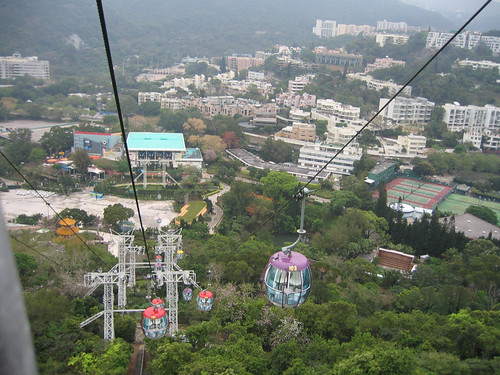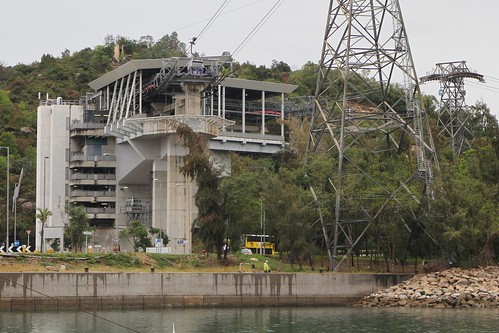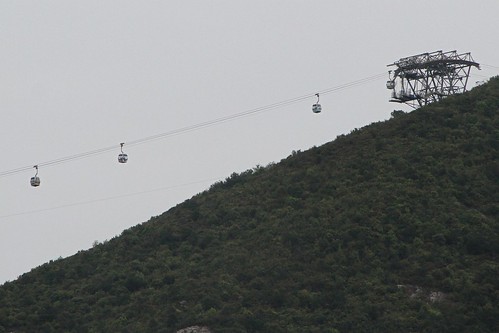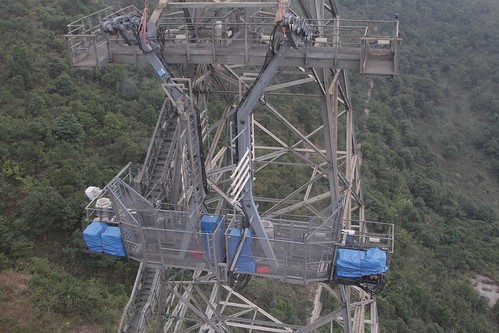The last thing you want to happen when riding a cable car is getting stuck in the air – but luckily for anyone in Hong Kong, the Fire Services Department are ready for any contingency, thanks to a variety of training rigs.
Fire and Ambulance Services Academy
The Fire and Ambulance Services Academy is a firefighter training facility operated by the Hong Kong Fire Services Department at Pak Shing Kok, outside Tseung Kwan O.
Provided with a variety of simulated locations for rescue operations.
The main duty of the High Angle Rescue Team (HART) is to carry out rescue operations at high angle locations with special features such as cable cars, tower cranes, bridge towers, scaffoldings at construction sites and suspended working platforms of high-rise buildings. Various high angle training facilities are provided in the Technical Rescue Training Area, which include a HAR tower, a simulated tower crane and a simulated cable car system for the training of HAR techniques to be employed by rescuers in various scenarios.
Ocean Park
Ocean Park is a Hong Kong theme park located in Aberdeen. The park is separated by a large mountain into two areas, linked by a 1.5-kilometre long cable car system.
Each car can hold six passengers, and with 252 cable cars across the two pairs of ropeways, 4,000 passengers can be moved per hour.
But around the corner at the ‘Aberdeen Fire Station Cum Ambulance Depot‘ I found something interesting up on the roof.
A dummy cable car gondola.
The Oriental Daily reported on the facility in 2012.
The Ocean Park cable car was found on the roof of the fire station?
The new Aberdeen Fire Station and Ambulance Station, which is adjacent to the Ocean Park and will be in service at the end of September this year, has spent $640,000 to create the cable car rescue training facility. It is understood that the training cable car and the cable above the new station are all directly from the Ocean Park.
The “real car” purchased is the first fire station in Hong Kong to introduce a real cable car for rescue training. It is expected to be used by 1,300 people every year, and it will allow firefighters to experience a simulated environment, as risks may arise during rescue in high-altitude environments.
It is reported that for many years, firefighters can only enter the Ocean Park in the morning for live cable car training. In the past one or two years, the training has increased to three nights a month, but the time is always limited.
The advantage of adding cable car training facilities in the new bureau is that it can flexibly allow personnel to be trained at all times and in all weather. The outer area of the cable car is also surrounded by platforms: The three-monthly practical training in Ocean Park will also be maintained.
Ngong Ping 360
Ngong Ping 360 is a 5.7 kilometre long cable car on Lantau Island, connecting the town of Tung Chung to the tourist attractions at Ngong Ping – home of the Po Lin Monastery and Tian Tan Buddha.
But hiding beneath the Airport Island angle station I found something curious.
A single gondola sitting atop a steel tower, disconnected to the main ropeway – erected as a training aid for emergency responders.
However the Fire Services Department also completes live training operations during maintenance shutdown windows, like this one in 2017.
Which was followed up with a night time rescue operation a few weeks later.
The Ngong Ping 360 emergency plan features two different rescue modes – the first using ropes.
Where the gondola is less than 60m above the ground the rescuer will ascend the tower nearest to the cabin in question, descent from the tower along the haul rope to the top of the cabin, and enter the cabin. The rescuee will be lowered directly from the cabin to the ground by using descender, safety harness and safety line.
The second method uses a ‘rescue carrier’ to provide access.
For locations where gondolas are higher than 60m from the ground then a rescue carrier from the designated tower will be moved to the rescuee’s cabin so that the rescuee will be transferred to the rescue carrier. The rescue carrier will be returned to the tower, and the rescuee will be conveyed to the ground through the tower’s staircase.
Four ‘rescue carriers’ exist on the Ngong Ping 360 ropeway – two parked beneath tower 3, beside Tung Chung Bay.
And two at Tower 7, just before the Ngong Ping station.
In an emergency the rescue carrier is placed onto the ropeway, then driven under it’s own power to the affected gondola, allowing the transfer of passengers.
The rescue carrier is tested regularly, but was damaged during a 2009 emergency drill after being incorrectly stowed.
Ngong Ping Cable Car’s emergency rescue vehicle crashed into a cable tower involving human negligence
December 14, 2009According to Hong Kong’s “Sing Tao Daily” report, during the drill at Ngong Ping 360 of Hong Kong Tung Chung Cable Car in the middle of last month, an accident happened suddenly. An emergency rescue vehicle slipped away from its original position when it was hooked up with a cable. And hit the cable tower platform, the body was slightly damaged, no one was injured. The engineer believed that the accident was caused by human negligence.
Ngong Ping 360 said on the 13th that an emergency rescue vehicle drill accident occurred on the 18th of last month. The crane was stopped that night and regular drills were being carried out. The emergency rescue vehicle usually parked on Tower 3 was installed with a cable, but in the process, The rescue vehicle suddenly slid away from the original position of the cable and crashed into the tower platform and was slightly damaged. Fortunately, there was no one on board and no one was injured.
The spokesperson pointed out that the rescue vehicle is an uncovered iron-pod crane. It is only dispatched during the rescue. It does not usually run on a cable. The accident that night occurred for the first time. He emphasised that the exercise adopts another set of operating mechanisms and will not affect it. Usually the cable car is in operation and the cable is not damaged.
Lu Jueqiang, an engineer from the Department of Mechanical Engineering of the Hong Kong Polytechnic University, pointed out that the emergency rescue vehicles are usually parked on the No. 3 and No. 7 cable towers. When the crane fails to stop, in order to rescue the trapped passengers up to 60 meters above the ground, the crane will be used to remove the cable. When the tower is moved out of the rescue vehicle and hung on the cable, when towed to the trapped crane, the rescuer will assist the passengers to climb down the rescue vehicle from the crane, and then pull the cable to retract the rescue vehicle, allowing the passengers to return to the cable tower.
Lu Jueqiang believes that the rescue vehicle was accidentally involved in the crane arm and the rescue vehicle was “missed” and placed in a crooked position. As a result, it slid back to the cable tower and collided. However, the rescue vehicle would not fall out because the crane arm was still attached to the rescue vehicle. He believes that people involved are not proficient in operation, and training should be strengthened.
As Ngong Ping 360 notified the EMSD two days after the accident and the rescue vehicle was repaired, a spokesperson for the Development Bureau revealed that the EMSD had issued a warning letter to Ngong Ping 360, instructing to notify the Ngong Ping 360 in accordance with the established mechanism, and the department’s engineers had contacted With the representative of Ngong Ping 360, inspected the recovered rescue vehicle to confirm that the rescue vehicle was operating normally, and launched an investigation into the incident, requesting to find out the cause and review the improvement measures.
A spokesperson for Ngong Ping 360 said that he had made a notification as required by the law at the time; but the department sent a letter to Ngong Ping 360 last Friday, reiterating that it must report according to the mechanism, that is, to give oral and written notifications within 30 minutes and 24 hours of the accident.
Footnote: cable car maintenance platforms
The Ngong Ping 360 cable car also has another oddball vehicle – an open air maintenance platform that circulates along the ropeway during normal services.
Further reading
- Hong Kong Yearbook 2016 – Fire Services
- Ngong Ping 360 – Visit to Fire and Ambulance Services Academy
- Ngong Ping 360 – Joint Exercise with Various Government Departments
- HK Association for Customer Service Excellence – Visit to Aberdeen Fire Station cum Ambulance Depot

















